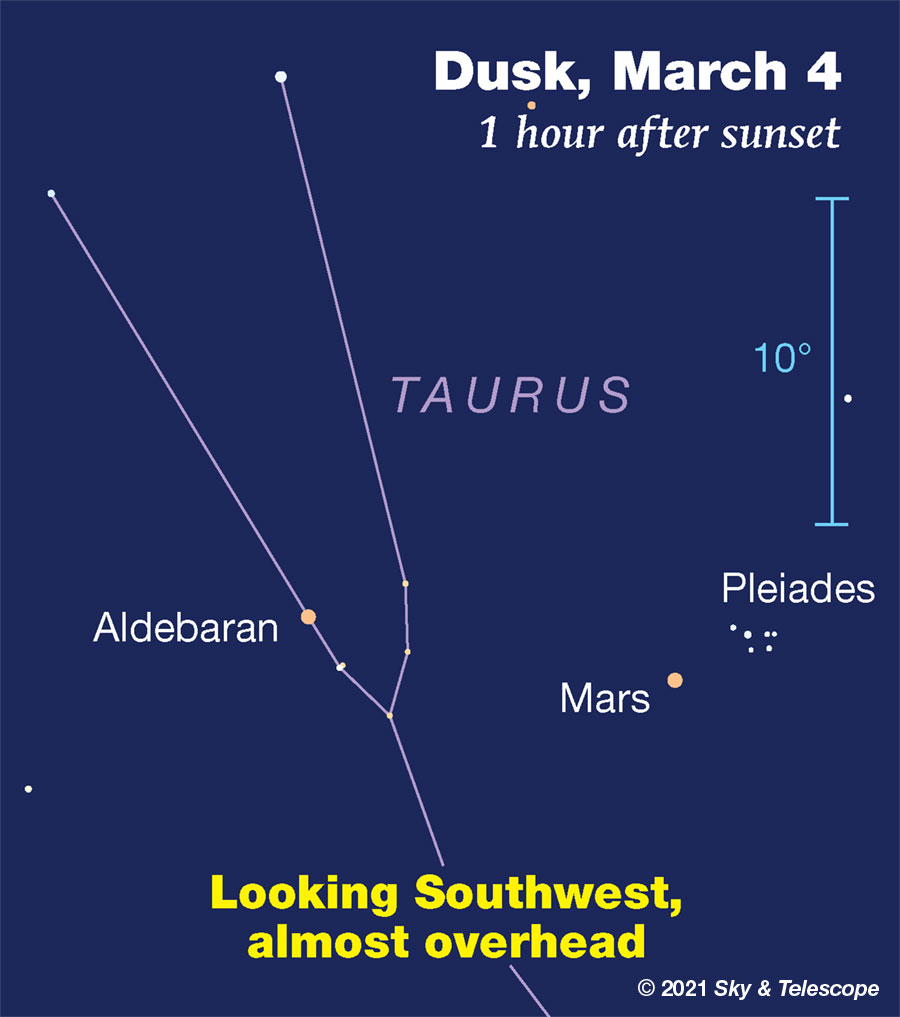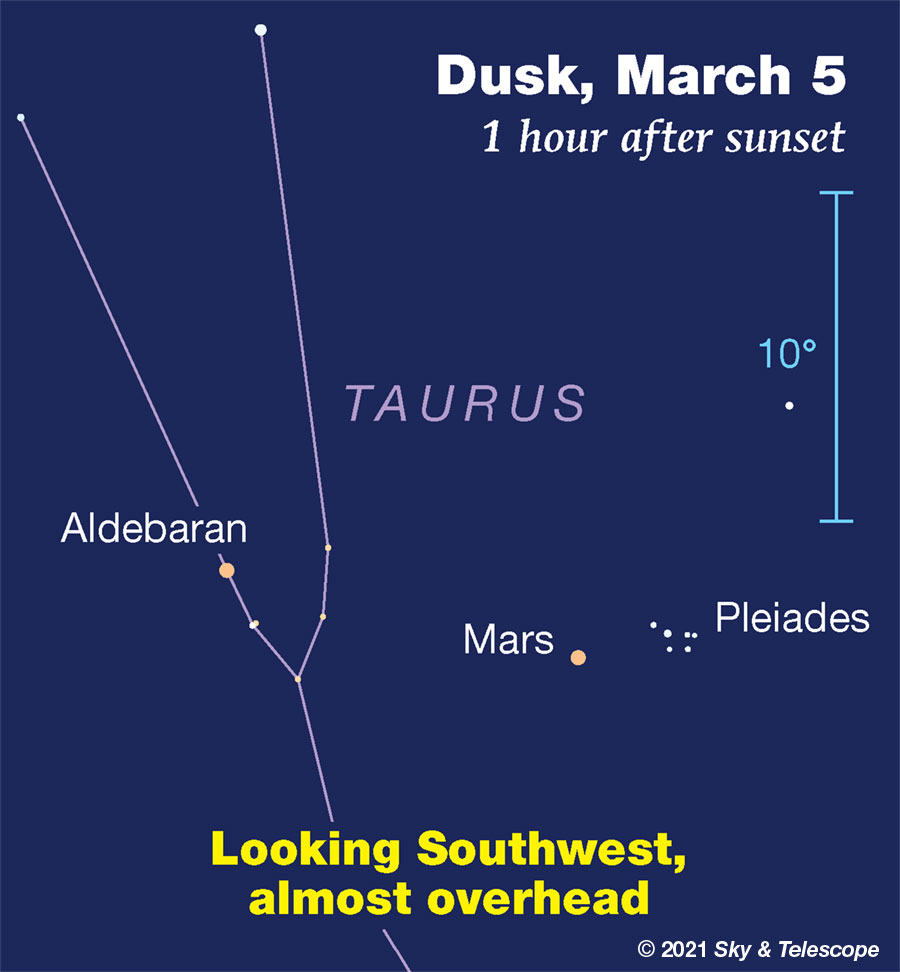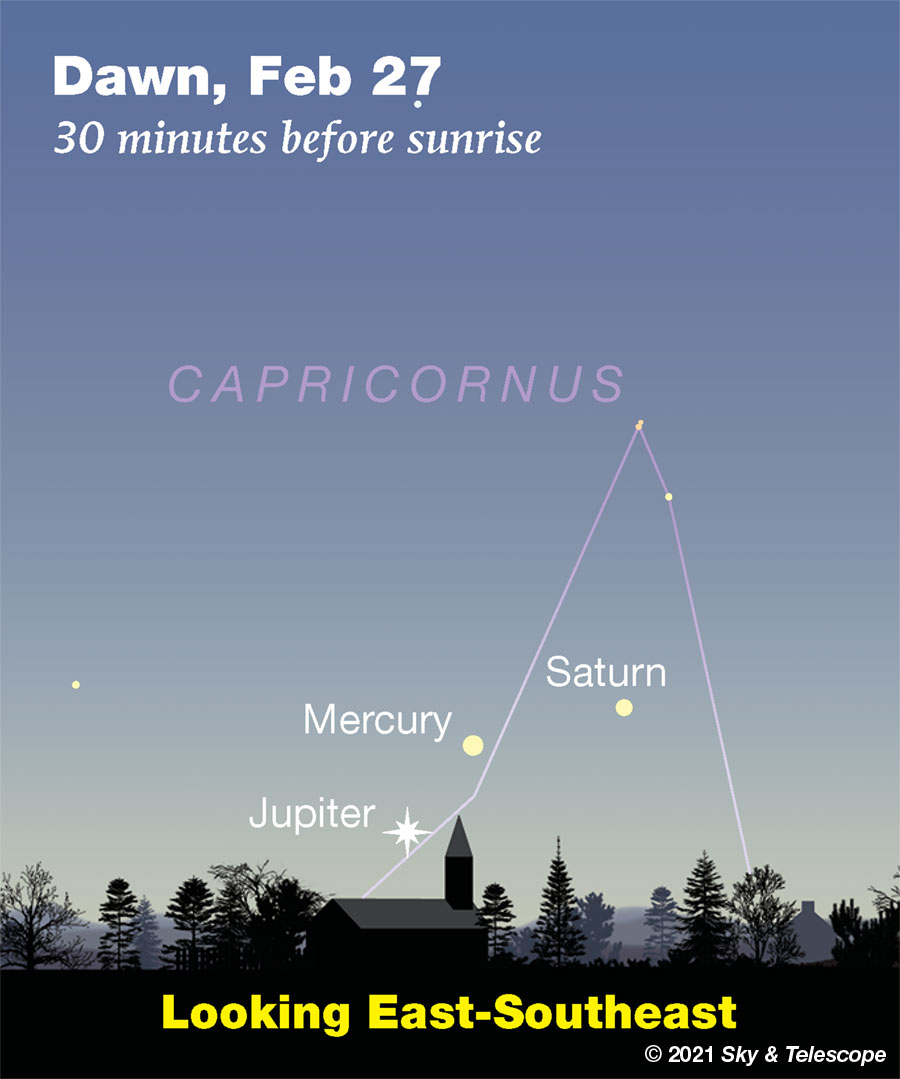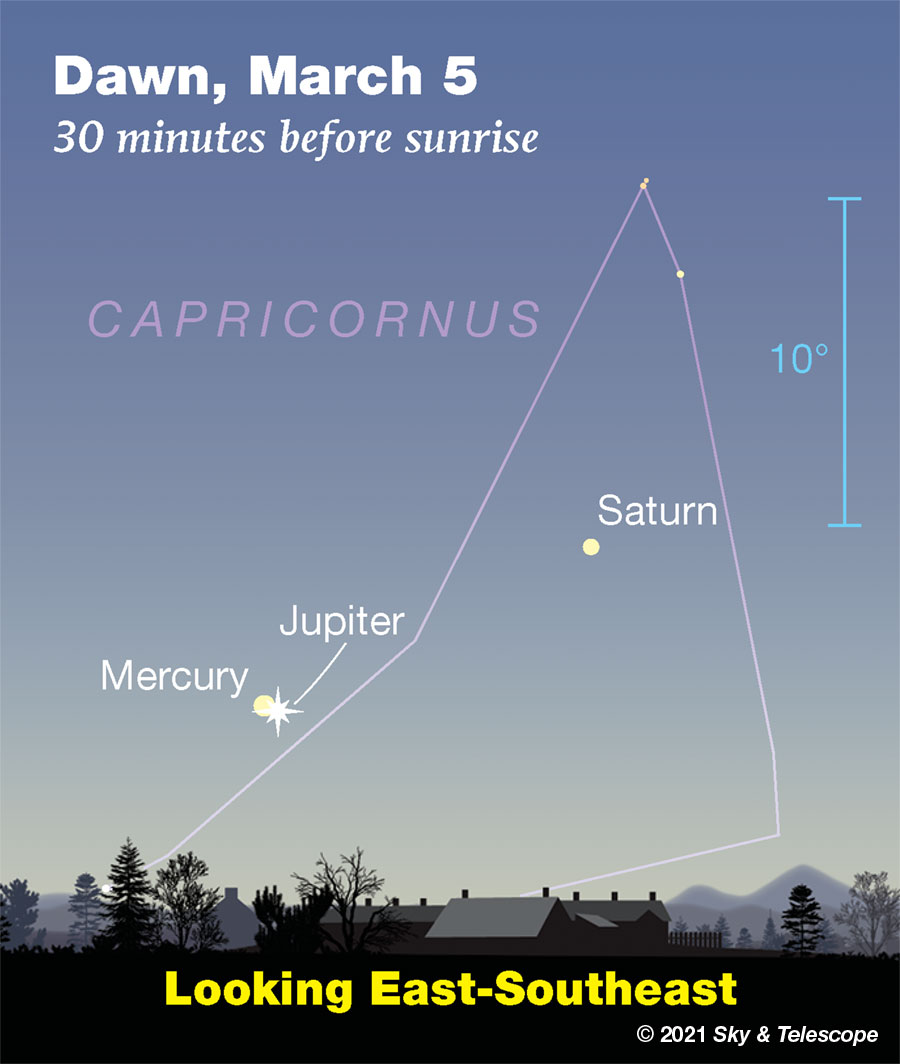FRIDAY, FEBRUARY 26
■ Full Moon tonight (exactly full at 3:17 a.m. Saturday morning EST), shining under the belly of Leo. In the evening through the moonlight, look for Regulus 7° to the Moon's upper right. Then find Algieba, a bit fainter, 7° above the Moon (for North America.) Bring binoculars to see through the glare – and maybe to measure your way: a typical binocular's field of view is about 6° wide.
SATURDAY, FEBRUARY 27
■ Denebola, Leo's 2nd-magnitude tail tip, shines some 7° left of the rising moon after dark.
SUNDAY, FEBRUARY 28
■ It's the end of February. So soon after dark now, the Big Dipper rises as high in the northeast as Cassiopeia has descended to in the northwest. Midway between them, as always, is Polaris.
MONDAY, MARCH 1
■ It's not spring for another 19 days, but the Spring Star Arcturus seems eager to thrust itself into view. It rises above the east-northeast horizon about an hour after dark now, depending on your latitude.
To see where to watch for this, find the Big Dipper as soon as the stars come out; it's high in the northeast. Follow the curve of its handle down and around to the lower right by a little more than a Dipper-length. That's the spot on the horizon to watch.
By 10 or 11 p.m. Arcturus dominates the eastern sky.
■ Algol should dip to its minimum brightness, magnitude 3.4 instead of its usual 2.1, for a couple hours centered on 11:21 p.m. EST (8:21 p.m. PST).
■ Will you be out before dawn Tuesday morning? The waning gibbous Moon will be shining in the southwest, offering telescopic views of a phase you're probably not used to. And spot Spica about 5° below the Moon (for North America).
TUESDAY, MARCH 2
■ Sirius blazes high in the south on the meridian by about 8 p.m. now. Using binoculars, examine the spot 4° south of Sirius (directly below it when it's near the meridian). Four degrees is somewhat less than the width of a typical binocular's field of view. Can you see a little patch of gray haze here? That's the open star cluster M41, about 2,200 light-years away. Its total magnitude adds up to 5.0.
Sirius, by comparison, is only 8.6 light-years away — and shines 400 times brighter.
WEDNESDAY, MARCH 3
■ After dinnertime at this time of year, five carnivore constellations are rising upright in a row from the northeast to south. They're all seen in profile with their noses pointed up and their feet (if any) to the right. These are Ursa Major the Big Bear in the northeast (with the Big Dipper as its brightest part), Leo the Lion in the east, Hydra the Sea Serpent in the southeast, Canis Minor the Little Dog higher in the south-southeast, and bright Canis Major the Big Dog in the south.
THURSDAY, MARCH 4
■ Mars is about 3° left of the Pleiades this evening through Saturday evening. Its background stars slide down a little farther to the lower right each day, as seen below.


■ Algol shines at minimum light for about two hours centered on 8:10 p.m. EST Thursday night.
■ Jupiter and Mercury are in conjunction very low in the dawn Friday morning, as shown in the second illustration of This Week's Planet Roundup below. Look very low in the east-southeast about a half hour before sunrise. Bring binoculars to see better through the bright sky. They'll be 0.6° apart for North America. Look carefully; Mercury is only an eighth as bright as Jupiter.
Also at dawn on the 5th: The last-quarter Moon shines in the south with Antares 5° below it.
FRIDAY, MARCH 5
■ February was Orion's month to stand at his at his highest in the south in early evening. Now March pushes him a little westward and brings his dog, Canis Major with Sirius, into that exalted meridian-transiting status.
In a moonless dark sky, the stars of Canis Major can be connected to form a nice dog profile, but through a brighter sky only his five brightest stars show well. These form the unmistakable Meat Cleaver. Sirius and Murzim (to its right) are the Cleaver's wide top end, with Sirius sparkling on its top back corner. Down to Sirius's lower left is the Cleaver's other end, including its short handle, formed by the triangle of Adhara, Wezen, and Aludra. The Cleaver is chopping toward the lower right.
■ Want to try for Sirius B, the famous white dwarf? Sirius A and B are now at the apparent widest of their 50-year orbit, 11 arcseconds apart, and will remain so for the next several years before they start closing up again. You'll want at least an 8-inch scope, a night of really excellent seeing (keep checking night after night), Sirius at its very highest like it is now, and the Sirius-B-hunting tips in Bob King's article Sirius B – A New Pup in My Life.
The Pup is east-northeast of the Dog Star and 10 magnitudes fainter: one ten-thousandth as bright. As Bob recommends, put a homemade occulting bar across your eyepiece's field stop: a tiny strip of aluminum foil held with a bit of tape. Hide blinding Sirius A just behind the strip's eastern edge.
SATURDAY, MARCH 6
■ With the Moon gone from the evening sky, this is a fine week to look for the zodiacal light if you live in the mid-northern latitudes. At this time of year the ecliptic tilts high upward from the western horizon at nightfall. From a clear, clean, dark site, look west at the very end of twilight for a vague but huge, tall pyramid of pearly light. It's tilted to the left, aligning along the constellations of the zodiac.
What you're seeing is sunlit interplanetary dust orbiting the Sun near the ecliptic plane.
■ Also for these moonless nights: Certain deep-sky objects hold secret surprises within or near them. Get out your telescope and sky atlas for a go at Bob King's eight Hidden Gems in Common Deep-Sky Objects now in evening view.
This Week's Planet Roundup
Mercury, Jupiter, and Saturn lurk very low in bright dawn. But Jupiter and Saturn are getting a little higher and less difficult to see each morning, while Mercury maintains its altitude and brightness. Look very low in the east-southeast about 30 minutes before sunrise, as shown below. With the sky that bright, bring binoculars.
Mercury remains about magnitude +0.3 this week. Saturn is magnitude +0.7, while Jupiter, though lower, is much brighter at mag –2.0.
Watch Jupiter close in on Mercury day by day. They reach conjunction, about 0.6° apart for North America, on the morning of March 5th.


Venus is out of sight in the glare of the Sun.
Mars (magnitude +0.9, in Taurus) passes the Pleiades this week. Look high in the west in early evening.
Upper left of Mars shines Aldebaran, essentially the twin of Mars in brightness now as well as color. Their separation shrinks from 15° to 12° this week. (They'll be passing 7° apart at the turn of spring on March 20th. And by the way, Mars and March have the same root. Our month name comes from the Roman Martius, "month of Mars.")
In a telescope Mars is a mere 6 arcseconds wide: a tiny bright blob.
Uranus (magnitude 5.8, in western Aries) is far below Mars in early evening. Finder chart.
Neptune is lost in the western evening twilight.
All descriptions that relate to your horizon — including the words up, down, right, and left — are written for the world's mid-northern latitudes. Descriptions that also depend on longitude (mainly Moon positions) are for North America.
Eastern Standard Time, EST, is Universal Time minus 5 hours. (Universal Time is also known as UT, UTC, GMT, or Z time. For the down-and-dirty details see Time and the Amateur Astronomer.)
Want to become a better astronomer? Learn your way around the constellations. They're the key to locating everything fainter and deeper to hunt with binoculars or a telescope.
This is an outdoor nature hobby. For an easy-to-use constellation guide covering the whole evening sky, use the big monthly map in the center of each issue of Sky & Telescope, the essential magazine of astronomy.
Once you get a telescope, to put it to good use you'll need a detailed, large-scale sky atlas (set of charts). The basic standard is the Pocket Sky Atlas (in either the original or Jumbo Edition), which shows stars to magnitude 7.6.

Next up is the larger and deeper Sky Atlas 2000.0, plotting stars to magnitude 8.5; nearly three times as many. The next up, once you know your way around, are the even larger Interstellarum atlas (stars to magnitude 9.5) or Uranometria 2000.0 (stars to magnitude 9.75). And be sure to read how to use sky charts with a telescope.
You'll also want a good deep-sky guidebook, such as Sky Atlas 2000.0 Companion by Strong and Sinnott, or the bigger (and illustrated) Night Sky Observer's Guide by Kepple and Sanner.
Can a computerized telescope replace charts? Not for beginners, I don't think, and not on mounts and tripods that are less than top-quality mechanically, meaning heavy and expensive. And as Terence Dickinson and Alan Dyer say in their Backyard Astronomer's Guide, "A full appreciation of the universe cannot come without developing the skills to find things in the sky and understanding how the sky works. This knowledge comes only by spending time under the stars with star maps in hand."
![]() Audio sky tour. Out under the evening sky with your
Audio sky tour. Out under the evening sky with your
earbuds in place, listen to Kelly Beatty's monthly
podcast tour of the heavens above. It's free.
"The dangers of not thinking clearly are much greater now than ever before. It's not that there's something new in our way of thinking, it's that credulous and confused thinking can be much more lethal in ways it was never before."
— Carl Sagan, 1996
"Facts are stubborn things."
— John Adams, 1770
 3
3









Comments
Rod
February 28, 2021 at 9:04 am
mary beth, New Jersey Eclipse Fan et al. This has been a messy winter for me concerning stargazing. If no snow and ice, now light rain and mud all around 🙂 I was able to view some sunspots on 26-Feb, AR2804 and AR2805 decaying quickly now (spaceweather.com) using my 90-mm refractor telescope with white light solar filter. On the evening of the 24-Feb, I did a bit of Moon observing 🙂
[Observed 1830-1900 EST/2330-2400 UT. I was out using 10x50 binoculars and looking at the Moon 🙂 M44 or Beehive cluster near 2.5 degrees away or less, just barely visible. The star Asellus Australis much easier to see. The Moon's orbit is carrying thru Cancer tonight. Starry Night Pro Plus 8 Sky Calendar shows for 7:00 PM or 2400 UT for tonight. Moonlight in binocular view quite bright, some altocumulus clouds moved by too, otherwise clear sky.]
I am still waiting for clear skies though, waiting, waiting, 🙂
You must be logged in to post a comment.
Rod
March 2, 2021 at 8:28 pm
I was out tonight from 1900-2000 EST. 10x50 binocular viewing of Mars near Pleiades. I could fit both into FOV, most of M45. Lovely bright orange-red Mars and Pleiades. Would make a very nice photo, wide angle view. 4 Vesta asteroid comes to opposition on 4th so I viewed using 10x50 binoculars, about 1.5 degree from Chertan star in Leo. Easy sight with 10x50 binoculars. Bob King reports in Celestial Calendar March issue page 48. Stellarium and Starry Night provided good charts to use. Fields too muddy now for telescope use so 10x50 binoculars did the trick tonight. Temperature 1C while viewing tonight. So Mars, Pleiades, and 4 Vesta asteroid observed this evening. Finally some clear skies here where I am at 🙂
You must be logged in to post a comment.
mary beth
March 3, 2021 at 12:18 pm
Hi Rod, was just going to comment on your first post. Glad to see the skies are clearing!
We cleared off yesterday and should have nice weather all week so I am looking forward to Orion blazing in the South and hopefully getting a peek of Arcturus and maybe even Spica if I stay up late enough! Keep us posted on your weather and field conditions. I’ll be really happy to hear that you can get your telescope out there...hopefully soon!
You must be logged in to post a comment.
You must be logged in to post a comment.